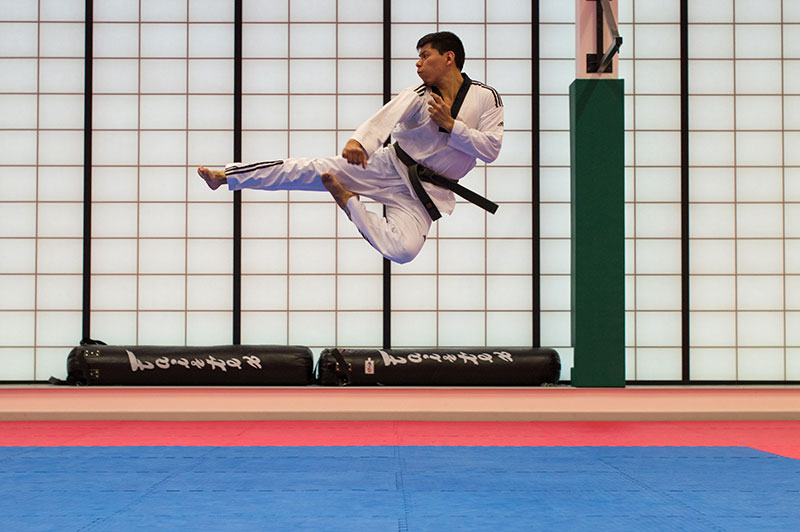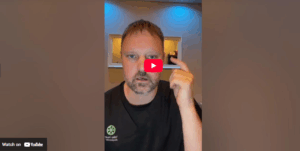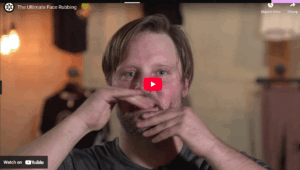When creating a training program for Taekwondo or any other sport, we start by addressing the client’s long-term goal. Then, we work our way into the details of more short-term goals.
In this way, short-term goals should work as a scaffold, helping to reach the client’s longer-term goal.
One way to do this is by starting with our yearly goals, and then reverse-engineering our, monthly, weekly, and daily goals. For clients who are athletes, the process is much the same; but instead of yearly goals, we look at goals for each of the three phases of a training cycle.
Training Cycle Goals
First, we’ll look through the largest lens: the yearly goal.
For athletes, the year is a cycle comprised of three phases: pre-season, competition, and post-season.
Each of these phases typically lasts between three and four months.
Pre-Season Phase
The first phase to look at is the pre-season phase. During this phase, we’re typically working on sports-specific movements and conditioning. That is, movements and conditioning that apply directly to the client’s sport.
To identify an athlete’s sport-specific movements, we look at these four categories:
1. The distance and velocity requirements of the sport.
- Short distance
- Medium distance
- Long distance
- Low speed
- Moderate speed
- High speed
2. The type of directional movement that the sport requires most.
- Horizontal and/or vertical
- Forwards and/or backward
- Lateral and/or rotational
3. The type of resistance that is encountered during movement.
- Heavy: ~300 lb
- Medium: ~100 lb
- Low: ~20 lb
- None: ~0 lb
4. The length of rest periods between exertions.
- No rest
- Short rest: ~30 seconds
- Medium rest: ~1-5 minutes
- Long rest: ~5-10 minutes
Using Pre-Season Sport-Specific Movement in Practice
| Type | Taekwondo | Basketball | Cross Country |
|---|---|---|---|
| Distance and Velocity | 26ft; High/Moderate | 95ft; High/Moderate | 5 miles; Moderate |
| Movement | Lateral & Horizontal | Vertical & Forward | Horizontal & Forward |
| Resistance | Low | Low | None |
| Rest | Medium & Long | Medium | None |
During the pre-season phase, we can use sport-specific movement in two ways:
- Special preparatory exercises engage the same muscles and energy systems as the sport, but utilize different movement patterns than those used during competition.One example of this is barbell and dumbbell training for maximum explosive strength. General jumping drills can fall into this category as well, but are more specific and will transfer more directly to the sport.
Special preparatory exercises for Taekwondo include the following:
- Quarter squats;
- High-intensity interval training with lateral jumps;
- Rotational medicine ball throws; and
- Single leg box jumps.
- Special developmental exercises engage the same muscle and energy systems as the sport; unlike special preparatory exercises, they also utilize the same movement patterns seen in competition. The competitive movements are typically trained and overloaded in some way to promote adaptation.It’s essential that these exercises are overloading in some way. The activity must be specific to the sport, and it must overload the system enough to stimulate adaptation and growth.
Often, people will choose exercises that are exactly the same as the sport-movement, and they’re not overloading the system in any way.
With special developmental exercises, the key is pushing the athlete to produce more force, or to move at a higher velocity, than they usually would in the ring. Overloading one of those qualities is what creates growth. (Tip: resistance bands are a great way to increase resistance for kicking.)
Example: A standard Taekwondo match is contested over three 2-minute rounds with a rest of 1 minute between rounds. To create overloading in practice, we can change these variables.
| Overload | Rounds | Length | Rest |
|---|---|---|---|
| Number of Rounds | 4 | 2 Minutes | 1 Minute |
| Length of Rounds | 3 | 4 Minutes | 1 Minute |
| Rest Period | 3 | 2 Minutes | 30 Seconds |
Competitive Phase
The next phase is the competitive phase, during which your client competes in their sport.
During this phase, the focus is again on sports-specific training. But we should spend less time building strength and cardio, and more time executing plans. (Focusing too much on strength-building and cardio in this phase increases the likelihood of injury and underperforming during competition.)
We want to continue strength-training so that we don’t lose any progress from the pre-season phase. But want to make sure not to overwork our athletes.
Another difference from pre-season is that in pre-season, you may work on more on special preparatory exercises, while in the competitive phase, you may work more on special developmental exercises.
Post-Season Phase
Last, we have the post-season phase. This is the time for the body to recover from competition. The goal during this phase is focusing on general physical fitness.
Post-season is also an opportunity to have fun, learn new skills, hone new movements and develop different energy systems.
General physical fitness can be categorized into the following movements and energy systems:
Movements
- Squat/hip hinge or hip extension;
- Single leg lunge;
- Upper body press;
- Upper body pull;
- Forward flexion/v-sit; and
- Rotational or twisting exercises.
Energy Systems
- ATP-Phosphocreatine;
- Glycolytic System/lactic acid; and
- Oxidative System/aerobic.
These exercises engage different energy systems and movement patterns than those that are involved during regular sports performance training.
General fitness exercises in this phase can be thought of as rehab: they won’t transfer to the sport directly, but instead, work to build a solid foundation of health and movement.
Focusing on general fitness in this way is especially useful for young athletes; sports-specific development can cause imbalances if training is done incorrectly.
This is also a time to focus on new skills. During the competition and pre-season phases, it’s unproductive to throw in new techniques that can’t be adequately learned and executed. But the post-season phase is the perfect time to do so.
Tips for Taekwondo
Taekwondo is different from most sports in that there are three main skill sets: forms, sparring, and self-defense.
These skillsets overlap, but they’re also unique, and each has its own specific needs.
Keep in mind that training for Taekwondo is like training for a triathlon rather than for basketball.
In general, it’s best to have each workout focus mainly on one discipline. For example, Monday and Wednesday focus on sparring; Tuesday and Thursday focus on forms; Friday focuses on self-defense.
During the post-season phase, workouts can incorporate more self-defense training, and during the competition phase, you may want to drop self-defense altogether because it’s not crucial at this time.
Taekwondo matches are three 2-minute rounds, generally with 45 seconds between them, depending on the event. But at Nationals, Pan Am Games, US Open, or World Championships, a fighter will often have more than 40 competitors in their division. To win gold in this case, they have to win five–or even six–matches. This requires enormous endurance. Essentially, you have to take what you would do to prepare for one match, and then multiply it by six or seven.
Matches are taxing–mainly to the ATP-Phosphocreatine and glycolytic system (lactic acid). But the recovery period after an activity is purely aerobic.
The aerobic system in comparison to other systems can create the highest number of ATPs from a single glucose molecule, but it requires a more extended period to do so.
For longer events, aerobic exercise comes into play. This does a few things for an athlete in the ring:
- The athlete is not worried about getting tired, so there’s no having to think about conserving energy. He’s able to attack at will and not be winded at all.
- When he attacks, he can choose how long the attack lasts without worrying about tiring.
- When he does make it to the semi-finals and finals, he’s still fresh and ready to go.
We found that conditioning is perhaps more important than technique at a certain point. Everyone can kick pads and things like that. But not many can do it full-bore for 5 or 6 matches. If we expect to have 5 matches to get to the finals, that’s 15 rounds plus the chance we are tied and go to golden round (golden point/overtime). So we train for 20 rounds allowing for the overtime and then, to be sure we don’t run out of gas we train for 23-25 rounds.
Monthly, Weekly, and Daily Goals
After addressing the long-term goals, we can now delve deeper into short-term goals on a monthly, weekly and daily timeframe.
Monthly
It’s essential to have a monthly goal because body adaptation–whether it’s mental or physical–takes time and repetition. Switching up goals too frequently will decrease long-term retention.
Weekly
Weekly goals are a breakdown of monthly goals into achievable smaller goals. In general, these goals will move from basic to more advanced.
Early on when learning a new skill, most of the adaptation is neurological, which means coordination is the most critical aspect.
It’s vital to learn the perfect technique with low to medium intensity, going through the motions and acquiring the necessary skills slowly. When the athlete is comfortable with a new method, then you can increase the intensity, speed, and randomness.
Lastly, you can begin to increase the conditioning difficulty to try and maintain perfect form at longer intervals and higher intensities. Start with higher reps, and move to a higher velocity.
You must first learn the technique correctly and safely to be able to use the technique in a competitive and variable environment.
In this way, you’re able to use high repetition to teach correct form, which reduces the risk of injury when the movement is performed in a variable environment at high velocity. The progression allows for the transfer of training to competition.
When picking weekly conditioning exercises and drills to supplement and improve the sport, we ask ourselves, “How do these drills and exercises transfer to the athlete’s performance in the ring?” This concept is known as the transfer of training.
Tips for Transfer of Training
- Use sport-specific movements and energy systems. Match categories (see pre-season).
- The distance or velocity requirements of the sport.
- The type of movement that the sport utilizes the most.
- The type of resistance that is encountered during movement.
- The type of rest/ energy system.
- Look for similarities between previously-learned skills and new skills.
- Maximize the similarity between training activities and competitive conditions. Simulate various elements of competition (e.g. arousal level, game intensity, spectator noise) occasionally during training sessions, particularly during the competition phase.
- Provide adequate experience with fundamental skills before advancing to more complex skills. Well-learned lead-up skills can positively influence an athlete’s performance in more demanding conditions at the next level of play (e.g., T-ball to baseball).
- Develop more general capabilities, such as critical gross motor skills, which apply to a variety of sport tasks. For example, in basketball, the vertical jump is a key element of rebounding and blocking shots.
- Point out to the athlete how training activities will improve sport performance. For example, call attention to the shifting of weight, the hip lead, and the arm movement in softball throw when teaching the javelin throw.
Daily
When structuring a workout for a taekwondo athlete, there are two daily goals: practicing a skill to improve performance and conditioning to improve the performance.
A general rule of thumb is that the skill comes before the conditioning. In other words, neurologically-taxing activities should come before physically-taxing activities. Neurologically-taxing activities involve paying attention, like when you learn and practice a new skill. You’re building new neural pathways and connections in the brain.
High-intensity training and efforts approaching 90% of the athlete’s capability are also severely taxing on the nervous system. In other words, weight follows speed–not only in the chronological sense (you go to the weight room after doing sprints and jumps on the track) but also in terms of priority. The more speed, power, and intensive, high outputs that an athlete is capable of, the less they need to do in the weight room.
Energy Management
An athlete’s energy every day, week, month, or season is like a cup with a limited amount of space: every stressor and stimulus imposed on an athlete is like a drop in that cup. The more stressful the activity, or the bigger stimulus, the larger the drop.
Part of our job as a trainer is deciding what should take up the most space in that cup–which stressors to impose at what times. Generally speaking, we want the most significant portion of that cup to be taken up by sport-specific practice.
The amount of space sports practice takes up will vary depending on the time of the year, but the thing that’s always the most beneficial to athletes is practicing their sport. Sports practice is the only irreplaceable part of an athlete’s training, so that’s what should fill the cup the most and what we should reserve the most space for.
After that, sprinting and jumping drills likely have a higher correlation to sporting success than most lifting movements. If a movement happens fast in the sport, faster movements are going to correlate better compared to slow ones.
Teach, Learn, Compete
There’s a lot to remember when you’re strategizing for a martial arts training schedule. But a good acronym to use is TLC: teach, learn, compete. At the beginning of a workout or training cycle, you teach by example. Then, you give the athletes learning opportunities with controlled focus drills. Finally, the athlete transfers their skills to compete in a more variable environment.


 Willard Sheppy is a writer and healthcare practitioner who seamlessly melds scientific knowledge with practical applications in engaging and authoritative articles. He holds a Bachelor of Science in Environmental Science from Oregon State University and a Master’s in Acupuncture and Oriental Medicine from the distinguished Oregon College of Oriental Medicine.
Willard Sheppy is a writer and healthcare practitioner who seamlessly melds scientific knowledge with practical applications in engaging and authoritative articles. He holds a Bachelor of Science in Environmental Science from Oregon State University and a Master’s in Acupuncture and Oriental Medicine from the distinguished Oregon College of Oriental Medicine.




